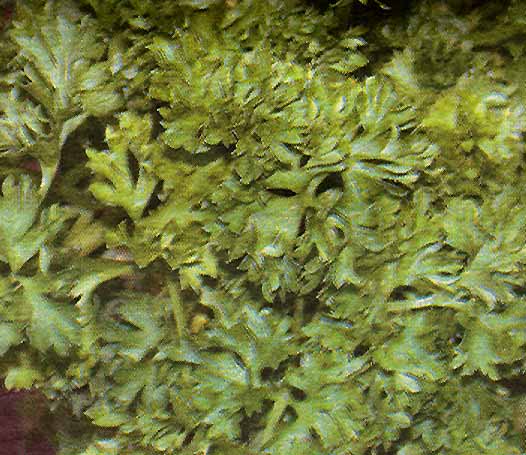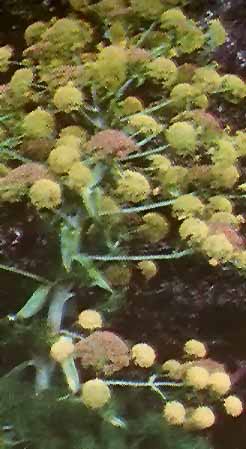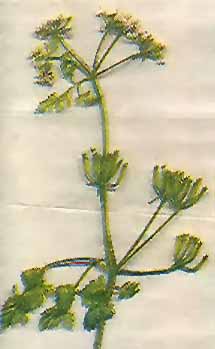 |
||
|
Cheerful Chervil
|
||
|
Used by the ancient Greeks to spice up bland dishes and as a crowning wreath, this flavoursome herb has become a kitchen essential. Just don't try picking it yourself... By Connie Phillipson Athens News |
||
The ancient Greeks called chervil "anthriskos" and "hairephyllon". I don't know and I can't guess the derivation of the first name, but the second is clear. The first particle is "hara" -joy, cheer, delight - and the second "phyllon", a leaf. Thus chervil was a cheer-leaf for the Greeks and, by extension, a herb of joy. Appropriately, it was used by them to spice various dishes as well as to crown their heads when the occasion demanded. |
||
|
There are actually two different plants we call by the same name. An annual whose scientific name is Anthriscus cerefolium, and a biannual called Chaerophyllum bulbosum, native of southern Russia, western Asia and of the Balkans. Both are related to the parsley and carrot families, and the plants closely resemble each other. |
 Chervil is a member of the aromatic carrot family, which also includes parsley and giant fennel |
|
|
But they are also similar to some other plants of the same family that are toxic and downright deadly. One of them is hemlock (Conium divaricatum and the more frequent C maculatum), the poison that killed Socrates. The other is rough chervil, "cerfeuil sauvage" and "persil d'ane" or donkey parsley (Anthriscus silvestris), a native. of western Europe which is decidedly toxic. If you are no herbalist or expert on herbal matters, please don't gather your own chervil. |
||
 Giant Fennel |
Unlike the Greeks who used tile plant as a herb to flavour other foods, the Romans cooked it by itself as one more vegetable. But as already noted, these might have been two different plants. One, the cerefolium of Dioscorides and Pliny, the herb we know as chervil which may be eaten by itself. And the second, the herb used for seasoning only, probably one of the species of meadow saxifrage (Seseli tortuosum) common in Greece and Italy and known to Theophrastus as "seseli", hence its other common English name "sweet cicely", from which the sweet name Cecilia derives. |
|
|
Chervil is incontestably one of the fines herbes of French cuisine, the others being parsley, chives and tarragon, extensively used in various sauces and salads and able to turn a common omelette into that exquisite "omelette aux fines herbes". Arguably, it is also a member of the "bouquet gami" (one bay leaf, a twig of thyme, a sprig of parsley, and optional a bit of rosemary); but whether it should take the place of parsley or be added as another optional like rosemary, I am not prepared to say. If, as d' Aigrefeuille maintained, the composition of a bouquet garnish is sufficiently crucial to have its ingredients weighed on jewellers' scales and weighed like diamonds in carats (1 carat = 1/5 of a gram), who am I to argue and suggest substitutions? Still, if you are a fennel buff, perhaps you may prefer chervil to parsley, Chervil has a taste somewhat subtler than parsley, but also a faint fennel scent that is absent in parsley. Today, it is the leaves of the chervil plant that are eaten, but it was not always so. In the 16th century it was the seeds that were favoured by the English, although they have a stronger flavour, which belies the claims that Anglo-Saxons are frightened by tastiness. Even if it is so now, it was certainly not so in the past. |
||
 Chervil |
Like many other herbs, and more so than most, the flavour and scent of chervil are destroyed by cooking. Therefore the fresh herb is often sprinkled finely chopped over the food, or if it must be cooked as in sauces, it is added just before the end of the preparation. But, as in every rule, there are exceptions. Ninon de Lenclos, famed 17th-century French courtesan and the matron of the most distinguished literary salon of her times, boiled chervil ruthlessly. But for her there was no question of taste. She washed her face twice a day with chervil water to prevent wrinkles from developing. And unlike Sappho, who wailed, "For now age sends ten thousand sandy wrinkles to roam upon my flesh, and Love is in no pressing haste to come flying to me with his gift of pain," Ninon de Lenclos had no complaints. She was still a beauty at the age of eighty. |
|
Recipes Brussels sprouts with Chervil Saute all ingredients except Brussels sprouts over medium heat for 3-4 minutes or until hot. 1 cup of fresh chervil Combine all the ingredients in a food processor until well chopped and blended. This is good on pasta, fish or mixed with cream cheese as an appetiser spread. |
||
HCS readers can view other excellent articles by Connie Phillipson in the News & Issues and especially the sections of our extensive, permanent archives at the URL http://www.helleniccomserve.com./contents.html
All articles of Athens News appearing on HCS have been reprinted with permission. |
||
|
||
|
|
||
|
2000 © Hellenic Communication Service, L.L.C. All Rights Reserved. http://www.HellenicComServe.com |
||

